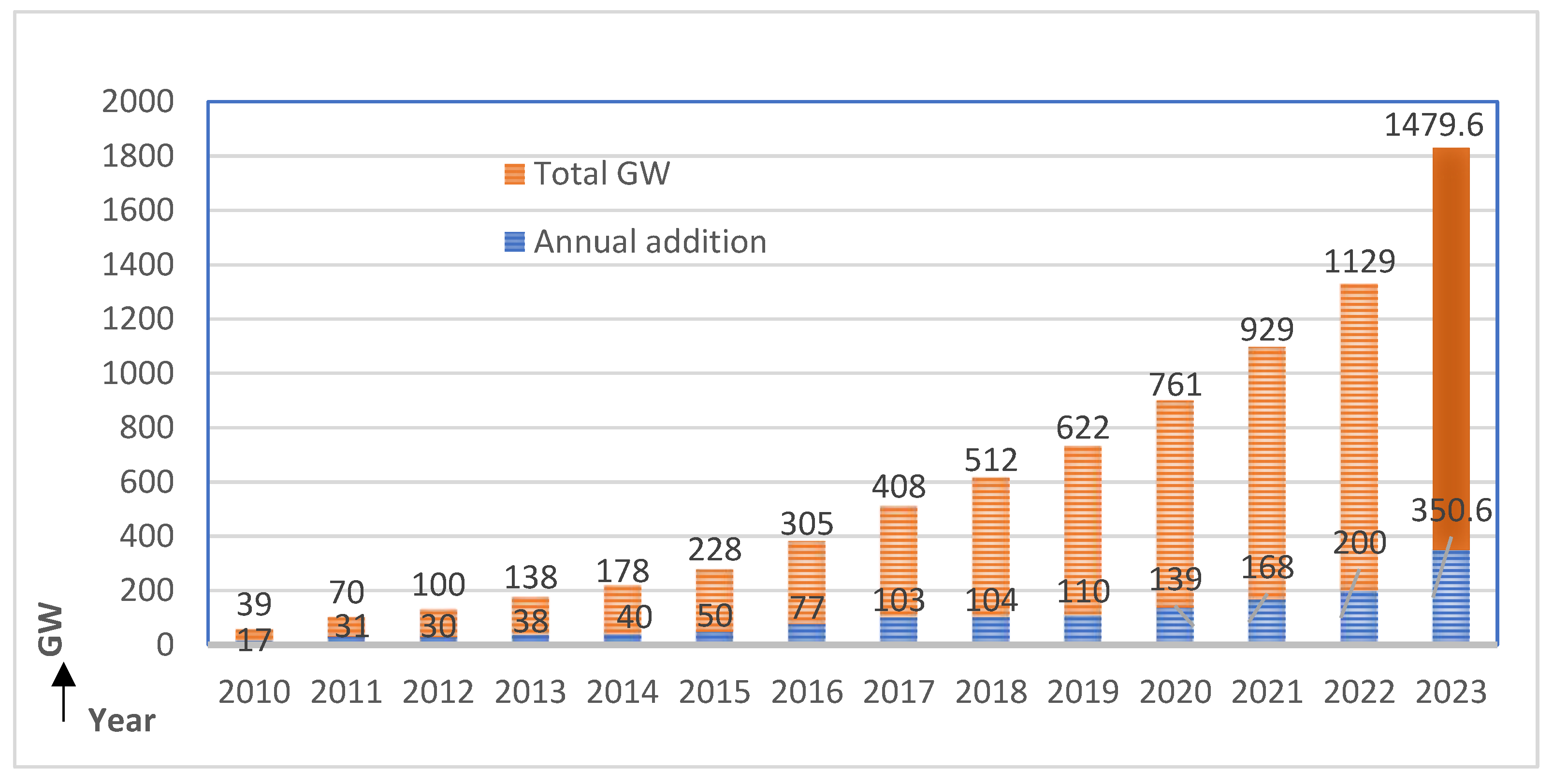A Study on Various Conditions Impacting the Harmonics at Point of Common Coupling in On-Grid Solar Photovoltaic Systems
Abstract
:1. Introduction
- ◦
- A detailed literature review on on-grid PV systems is presented, considering the essential components of PV systems and their functions. Further, we discuss the different PV-inverter topologies, control and modulation techniques, and potential causes of harmonics, including their mitigation strategies;
- ◦
- An on-grid PV system was modeled using MATLAB/Simulink to demonstrate some use cases. The use-cases examined through this simulation can be summarized as follows:
- ▪
- Impact of variable climatic conditions (temperature, T; irradiance, G) on the on-grid PV systems with constant load,
- ▪
- Impact of variable loads on the on-grid PV systems at constant climatic conditions,
- ▪
- Impact of harmonics with different loading levels of non-linear loads;
- ◦
- Furthermore, simulations were conducted using our real-time digital simulator (OPAL-RT) to validate the results. The use cases for this study are as follows:
- ▪
- The effect of different loads (linear, non-linear, and arc-furnace) on THD at PCC,
- ▪
- The effect of change in climatic conditions (irradiance, G) on THD at PCC,
- ▪
- The effect of change in tuning parameters such as proportional gain (kp) and integral gain (ki) of the inverter controller on THD at PCC.
2. On-Grid PV System
2.1. Components of On-Grid PV System
2.1.1. Filter Circuit
2.1.2. PV Inverters and Their Types
2.1.3. Solar PV Array and Net Meter
2.2. Topologies, Control, and Modulation Strategies in On-Grid PV Systems
2.2.1. On-Grid PV System Topologies
2.2.2. Control Strategies for On-Grid PV Inverters
2.2.3. Types of Control and Modulation Strategies for On-Grid PV-Inverters
- Linear controllers:
- Phase-locked loop (PLL)-based classical controllers,
- Proportional resonant (PR) controllers,
- Linear quadratic Gaussian (LQG) controllers;
- Non-linear controllers:
- Sliding mode controllers (SMC),
- Partial or full feedback linearization controllers,
- Hysteresis controllers;
- Predictive controllers:
- Model predictive controllers (MPC),
- Deadbeat controllers (DBC);
- Adaptive controllers;
- Intelligent controllers:
- Neural network controllers (NNC),
- Repetitive controllers (RC),
- Fuzzy logic controllers (FLC).
2.3. Sources of Harmonics Generation and Their Mitigation Strategies in On-Grid PV Systems
2.3.1. Sources of Harmonics Generation in On-Grid PV Systems
- ➢
- PWM techniques: The primary source of voltage harmonics is PWM techniques that control the inverter. PWM techniques generally need to work at a considerably high switching frequency (fsw) for the switching operation of inverter switches (e.g., IGBTs), which leads to high harmonics at inverter output [41]. The voltage will have a modulated waveform at the inverter output due to the harmonics caused by the load, e.g., non-linear load, and the control techniques used by the inverter;
- ➢
- Effect of the inverter’s DC-side impedance:
- If a large inductance is used to connect at the DC side of the PV inverter for smoothening the DC, then this type of harmonic source behaves like a current source and is called a current-type harmonic source,
- If the capacitance is used to connect at the DC side of the PV inverter for smoothening the DC voltage, then this type of harmonic source behaves like a voltage source and is called a voltage-type harmonic source.
- ➢
- A double-frequency voltage ripple on the DC-link voltage creates a sequence of odd harmonics in the output current in the case of single-phase grid-tied PV inverters. This is because the reference current generated by the control technique uses the DC-link voltage. Hence, the inverter output current will also contain the same odd harmonic, as shown in Figure 6. Thus, if these odd harmonics are not addressed before reaching the grid, they will propagate into the grid and impact other equipment connected to the grid [44].
- ➢
- The current harmonics from the PV inverter also depend on the climate variations of the day. During the sunrise and sunset (low irradiance), it is observed that a high level of current THD is produced from the PV inverter [45]. For example, there was a study on a PV plant in the Turkey-Mardin Province in March 2021, in which it was identified that solar irradiance and the power factor (pf) are directly proportional [46]. In addition, the relationship between the pf and THD can be mathematically identified in Equation (2).where k is the power factor coefficient defined as k = 1/{1 + (THDi)2}; from this, it can be understood that % THD is low at high irradiance, whereas the %THD is very high at low irradiance, which is unacceptable, as shown in Figure 7.pf = k × cos(φ)
- ➢
- When the PV inverter is connected to the grid, current harmonics from the PV inverter interact with the grid impedance, thus generating voltage harmonics on the PCC [47];
- ➢
- Harmonic levels at PCC also depend on the network load variations and the PV penetration level. The changes in the load connected to the PCC are observed to affect the harmonic voltages generated from the PV inverter. The PV penetration level also affects the harmonics generated by PV inverters [48].
2.3.2. Harmonic Mitigation Strategies
3. Results and Discussions
3.1. Simulation Study of On-Grid PV System: Use Cases
3.1.1. Case 1: On-Grid PV System with Constant Load at Variable Temperature (T) and Irradiance (G)
3.1.2. Case 2: On-Grid PV System with Variable Loads at Constant Temperature (T) and Irradiance (G)
3.1.3. Harmonic Study with Different Levels of Non-Linear (NL) Loads
3.2. OPAL-RT Implementation of On-Grid PV System: Use Cases
3.2.1. Effect of Non-Linear Loads on THD at PCC
3.2.2. Effect of Furnace Load on THD at PCC
3.2.3. Effect of Change in Irradiance (G) on THD at PCC
3.2.4. Effect of Load Change on THD at PCC
3.2.5. Effect of Change of Tuning Parameters of (kp, ki) of Inverter Controller on THD at PCC
3.2.6. Effect of Grid-Side Voltage Harmonics on THD at PCC
4. Conclusions
Author Contributions
Funding
Data Availability Statement
Conflicts of Interest
Appendix A
References
- Renewables 2022 Global Status Report. Available online: https://www.ren21.net/wp-content/uploads/2019/05/GSR2023_GlobalOverview_Full_Report_with_endnotes_web.pdf (accessed on 4 August 2023).
- Available online: https://www.pv-magazine.com/2023/02/16/global-solar-installations-may-hit-350-6-gw-in-2023-says-trendforce/ (accessed on 1 August 2023).
- IEEE Std 1100-2005; IEEE Recommended Practice for Powering and Grounding Electronic Equipment-Redline. IEEE Standards Association: Piscataway, NJ, USA, 2006.
- Alsaif, A.K. Challenges and benefits of integrating renewable energy technologies into AC power system Grid. Am. J. Eng. Res. 2017, 6, 95–100. [Google Scholar]
- Jiao, S.; Raj, K.; Rajashekara, K. A Novel DROGI Algorithm for Non-linear Unbalanced Load Compensation using Four-leg Converter. In Proceedings of the 2020 IEEE Applied Power Electronics Conference and Exposition (APEC), New Orleans, LA, USA, 15–19 March 2020; pp. 3282–3286. [Google Scholar]
- Reza, M.H.; Shobug, M.A. Efficiency Evaluation of P&O MPPT Technique used for Maximum Power Extraction from Solar Photovoltaic System. In Proceedings of the 2020 IEEE Region 10 Symposium (TENSYMP), Dhaka, Bangladesh, 5–7 June 2020; pp. 1808–1811. [Google Scholar]
- Patel, V.; Patel, J.J. Power quality improvement of grid using solar photovoltaic farm. In Proceedings of the 2017 Innovations in Power and Advanced Computing Technologies (i-PACT), Vellore, India, 21–22 April 2017; pp. 1–6. [Google Scholar]
- Ortiz, A.; Gherasim, C.; Manana, M.; Renedo, C.J.; Eguiluz, L.I.; Belmans, R.J. Total harmonic distortion decomposition depending on distortion origin. IEEE Trans. Power Deliv. 2005, 20, 2651–2656. [Google Scholar]
- Papaioannou, I.T.; Bouhouras, A.S.; Marinopoulos, A.G.; Alexiadis, M.C.; Demoulias, C.S.; Labridis, D.P. Harmonic impact of small photovoltaic systems connected to the LV distribution network. In Proceedings of the 2008 5th International Conference on the European Electricity Market, Lisboa, Portugal, 28–30 May 2008; pp. 1–6. [Google Scholar]
- Schlabbach, J. Harmonic current emission of photovoltaic installations under system conditions. In Proceedings of the 2008 5th International Conference on the European Electricity Market, Lisboa, Portugal, 28–30 May 2008; pp. 1–5. [Google Scholar]
- Liu, J. The main factors influencing the harmonic level of grid connected photovoltaic analysis. Electr. Technol. 2009, 12, 66–67. [Google Scholar]
- Schlabbach, J.; Grob, A.; Chicco, G. Influence of Harmonic System Voltages on the Harmonic Current Emission of Photovoltaic Inverters. In Proceedings of the 2007 International Conference on Power Engineering, Energy and Electrical Drives, Setubal, Portugal, 12–14 April 2007; pp. 545–550. [Google Scholar]
- Gan, C.K.; Tan, P.H.; Khalid, S. System Performance Comparison Between Crystalline and Thin-Film Technologies under Different Installation Conditions. In Proceedings of the 2013 IEEE Conference on Clean Energy and Technology (CEAT), Langkawi, Malaysia, 18–20 November 2013; pp. 362–367. [Google Scholar]
- Rodriguez, J.R.; Ruiz, F.; Biel, D.; Guinjoan, F. Simulation and analysis of distributed PV generation in a LV network using MATLAB-Simulink. In Proceedings of the 2010 IEEE International Symposium on Circuits and Systems, Paris, France, 30 May–2 June 2010; pp. 3–6. [Google Scholar]
- Available online: https://greenridgesolar.com/2020/11/types-of-solar-inverters/ (accessed on 4 August 2023).
- Available online: https://sinovoltaics.com/learning-center/inverters/central-inverters/ (accessed on 1 August 2023).
- Available online: https://energyresearch.ucf.edu/consumer/solar-technologies/solar-electricity-basics/cells-modules-panels-and-arrays/ (accessed on 4 August 2023).
- Zeb, K.; Uddin, W.; Khan, M.A.; Ali, Z.; Ali, M.U.; Christofides, N.; Kim, H.J. A comprehensive review on inverter topologies and control strategies for grid connected photovoltaic system. Renew. Sustain. Energy Rev. 2018, 94, 1120–1141. [Google Scholar]
- Attanasio, R.; Cacciato, M.; Gennaro, F.; Scarcella, G. Review on single-phase PV inverters for grid-connected applications. In Proceedings of the 4th IASME/WSEAS, International Conference on Energy, Environment, Ecosystems and Sustainable Development (EEESD’08), Algarve, Portugal, 11–13 June 2008. [Google Scholar]
- Gerardo, V.G.; Raymundo, M.R.P.; Miguel, S.Z.J. High efficiency single-phase transformer-less inverter for photovoltaic applications. Ing. Investig. Tecnol. 2015, 16, 173–184. [Google Scholar] [CrossRef]
- Anzalchi, A.; Sundararajan, A.; Moghadasi, A.; Sarwat, A. High-Penetration Grid-Tied Photovoltaics: Analysis of power quality and feeder voltage profile. IEEE Ind. Appl. Mag. 2019, 25, 83–94. [Google Scholar]
- IEA International Energy Agency. High Penetration of PV in Local Distribution Grids: Case Study Collection; IEA International Energy Agency: Paris, France, 2014. [Google Scholar]
- Yaskawa Solectria Solar. Total Harmonics Distortion in Grid-Connected Photovoltaic Inverters and Strategies for Their Mitigation; Yaskawa Solectria Solar: Lawrence, MA, USA.
- Varatharajan, A.; Schoettke, S.; Meyer, J.; Abart, A. Harmonic emission of large PV installations case study of a 1 MW solar campus. In Proceedings of the ICREPQ International Conference on Renewable Energies and Power Quality, Cordoba, Spain, 8–10 April 2014; pp. 8–10. [Google Scholar]
- Xiong, L.; Nour, M.; Shahin, M. Harmonic analysis of high penetration level of Photovoltaic generation in distribution network and solution studies. In Proceedings of the 2019 8th International Conference on Modeling Simulation and Applied Optimization (ICMSAO), Manama, Bahrain, 15–17 April 2019; pp. 1–5. [Google Scholar]
- Aprilia, E.C. Modelling of Photovoltaic (PV) Inverter for Power Quality Studies. Master’s Thesis, Department of Electrical Engineering, Eindhoven University of Technology, Eindhoven, The Netherlands, 2012. [Google Scholar]
- Anzalchi, A.; Sundararajan, A.; Moghadasi, A.; Sarwat, A. Power quality and voltage profile analyses of high penetration grid-tied photovoltaics: A case study. In Proceedings of the 2017 IEEE Industry Applications Society Annual Meeting, Cincinnati, OH, USA, 1–5 October 2017; pp. 1–8. [Google Scholar]
- Abad, G. (Ed.) Power Electronics and Electric Drives for Traction Applications; John Wiley & Sons: Hoboken, NJ, USA, 2016. [Google Scholar]
- Zeng, Z.; Yang, H.; Zhao, R.; Cheng, C. Topologies and control strategies of multi-functional grid-connected inverters for power quality enhancement: A comprehensive review. Renew. Sustain. Energy Rev. 2013, 24, 223–270. [Google Scholar]
- Surprenant, M.; Hiskens, I.; Venkataramanan, G. Phase locked loop control of inverters in a microgrid. In Proceedings of the 2011 IEEE Energy Conversion Congress and Exposition, Phoenix, AZ, USA, 17–22 September 2011; pp. 667–672. [Google Scholar]
- Castilla, M.; Miret, J.; Matas, J.; de Vicuna, L.G.; Guerrero, J.M. Linear Current Control Scheme with Series Resonant Harmonic Compensator for Single-Phase Grid-Connected Photovoltaic Inverters. IEEE Trans. Ind. Electron. 2008, 55, 2724–2733. [Google Scholar] [CrossRef]
- Huerta, F.; Pizarro, D.; Cobreces, S.; Rodriguez, F.J.; Giron, C.; Rodriguez, A. LQG servo controller for the current control of LCL grid-connected voltage-source converters. IEEE Trans. Ind. Electron. 2011, 59, 4272–4284. [Google Scholar] [CrossRef]
- Cortajarena, J.A.; Barambones, O.; Alkorta, P.; De Marcos, J. Sliding mode control of grid-tied single-phase inverter in a photovoltaic MPPT application. Sol. Energy 2017, 155, 793–804. [Google Scholar]
- Sharma, R.; Suhag, S. Feedback linearization-based control for weak grid-connected PV system under normal and abnormal conditions. Front. Energy 2020, 14, 400–409. [Google Scholar] [CrossRef]
- Mohamed, S.R.; Jeyanthy, P.A.; Devaraj, D. Hysteresis-based voltage and current control techniques for grid connected solar photovoltaic systems: Comparative study. Int. J. Electr. Comput. Eng. (IJECE) 2018, 8, 2671–2681. [Google Scholar] [CrossRef]
- Hong, W.; Tao, G. An Adaptive Control Scheme for Three-phase Grid-Connected Inverters in Photovoltaic Power Generation Systems. In Proceedings of the Annual American Control Conference (ACC), Milwaukee, WI, USA, 27–29 June 2018; pp. 899–904. [Google Scholar]
- Ghasemi, A.; Sedighizadeh, M.; Fakharian, A.; Nasiri, M.R. Intelligent voltage and frequency control of islanded micro-grids based on power fluctuations and communication system uncertainty. Int. J. Electr. Power Energy Syst. 2022, 143, 108383. [Google Scholar] [CrossRef]
- Fang, Y.; Zhu, Y.; Fei, J. Adaptive intelligent sliding mode control of a photovoltaic Grid-connected inverter. Appl. Sci. 2018, 8, 1756. [Google Scholar]
- Naidu, T.A.; Arya, S.R.; Maurya, R. Phase Locked Loop Based on Third Order SSI for Compensation of Voltage-Related Power Quality Issues Using DVR. Electr. Power Compon. Syst. 2019, 47, 329–344. [Google Scholar] [CrossRef]
- Naidu, T.A.; Arya, S.R.; Maurya, R.; Padmanaban, S. Performance of DVR Using Optimized PI Controller Based Gradient Adaptive Variable Step LMS Control Algorithm. IEEE J. Emerg. Sel. Top. Ind. Electron. 2021, 2, 155–163. [Google Scholar] [CrossRef]
- De Jaeger, E.; Koo, K.L.; Juncheng, L.; Chan, K.; Desmet, J.; Zavoda, F.; Bollen, M.H.J.; Ronnberg, S.K.; Meyer, J.; Council on Large Electric Systems (CIGRE). Power Quality and EMC Issues with Future Electricity Networks; Council on Large Electric Systems (CIGRE): Paris, France, 2018. [Google Scholar]
- Li, D.; Tian, J. A novel active power filter for the voltage-source type harmonic source. In Proceedings of the 2008 International Conference on Electrical Machines and Systems, Wuhan, China, 17–20 October 2008; pp. 2077–2080. [Google Scholar]
- Ertasgin, G. Low-Cost Current-Source 1-Ph Photovoltaic Grid-Connected Inverter. Ph.D. Thesis, University of Adelaide, Adelaide, Australia, 2010. [Google Scholar]
- Du, Y.; Lu, D.D.-C.; Chu, G.M.L.; Xiao, W. Closed-form solution of time-varying model and its applications for output current harmonics in two-stage PV inverter. IEEE Trans. Sustain. Energy 2014, 6, 142–150. [Google Scholar]
- Block, P.A.B.; Salamanca, H.L.L.; Teixeira, M.D.; Dahlke, D.B.; Shiono, O.M.; Donadon, A.R.; Camargo, J.C. Power quality analyses of a large-scale photovoltaic system. In Proceedings of the 2014 5th International Renewable Energy Congress (IREC), Hammamet, Tunisia, 25–27 March 2014; pp. 1–6. [Google Scholar]
- Cangi, H.; Adak, S. Quality Problems in Low İrradiance at Grid Connected PV Solar System. July 2022, pp. 1–11. Available online: https://www.researchsquare.com/article/rs-1812960/v1 (accessed on 4 August 2023).
- Hamid, M.I.; Anwari, M.; Gaonkar, D.N. Single-phase photovoltaic-inverter operation characteristic in distributed generation system. In Distributed Genaration; INTECH: Houston, TX, USA, 2010; pp. 141–165. [Google Scholar]
- Ibrahem, H.; Yehia, D.M.; Azmy, A.M. Power Quality Investigation of Distribution Networks with High Penetration of Solar Energy. In Proceedings of the 2019 21st International Middle East Power Systems Conference (MEPCON), Cairo, Egypt, 17–19 December 2019; pp. 1193–1198. [Google Scholar]
- IEEE Std 519-2022; IEEE Recommended Practices and Requirements for Harmonic Control in Electrical Power Systems. IEEE Standards Association: Piscataway, NJ, USA, 2022.
- IEEE Std 1547-2003; IEEE Standard for Interconnecting Distributed Resources with Electric Power Systems. IEEE Standards Association: Piscataway, NJ, USA, 2009.
- IEC 61727-2004; Photovoltaic (PV) Systems—Characteristics of the Utility Interface. IEC-International Electrotechnical Commission: Geneva, Switzerland, 2004.
- Matre, M. Harmonics in Photovoltaic Inverters & Mitigation Techniques; Sterling & Wilson: Mumbai, India, 2020. [Google Scholar]
- Zhou, K.; Yang, Y.; Blaabjerg, F.; Wang, D. Optimal selective harmonic control for power harmonics mitigation. IEEE Trans. Ind. Electron. 2014, 62, 1220–1230. [Google Scholar]
- Yang, Y.; Zhou, K.; Wang, H.; Blaabjerg, F.; Wang, D.; Zhang, B. Frequency adaptive selective harmonic control for grid-connected inverters. IEEE Trans. Power Electron. 2014, 30, 3912–3924. [Google Scholar]
- Liang, X.; Andalib-Bin-Karim, C. Harmonic mitigation through advanced control methods for grid-connected renewable energy sources. In Proceedings of the 2017 IEEE Industry Applications Society Annual Meeting, Cincinnati, OH, USA, 1–5 October 2017; pp. 1–12. [Google Scholar]
- Chaoui, A.; Krim, F.; Gaubert, J.-P.; Rambault, L. DPC controlled three-phase active filter for power quality improvement. Int. J. Electr. Power Energy Syst. 2008, 30, 476–485. [Google Scholar] [CrossRef]
- Munir, S.; Li, Y.W. Residential distribution system harmonic compensation using PV interfacing inverter. IEEE Trans. Smart Grid 2013, 4, 816–827. [Google Scholar] [CrossRef]
- Li, Y.W.; He, J. Distribution system harmonic compensation methods: An overview of DG-interfacing inverters. IEEE Ind. Electron. Mag. 2014, 8, 18–31. [Google Scholar]
- Liang, X.; Andalib-Bin-Karim, C. Harmonics and mitigation techniques through advanced control in grid-connected renewable energy sources: A review. IEEE Trans. Ind. Appl. 2018, 54, 3100–3111. [Google Scholar] [CrossRef]
- He, J.; Li, Y.W. Hybrid voltage and current control approach for DG-grid interfacing converters with LCL filters. IEEE Trans. Ind. Electron. 2012, 60, 1797–1809. [Google Scholar]
- Salem, M.; Atia, Y. Control scheme towards enhancing power quality and operational efficiency of single-phase two-stage grid-connected photovoltaic systems. J. Electr. Syst. Inf. Technol. 2015, 2, 314–327. [Google Scholar]
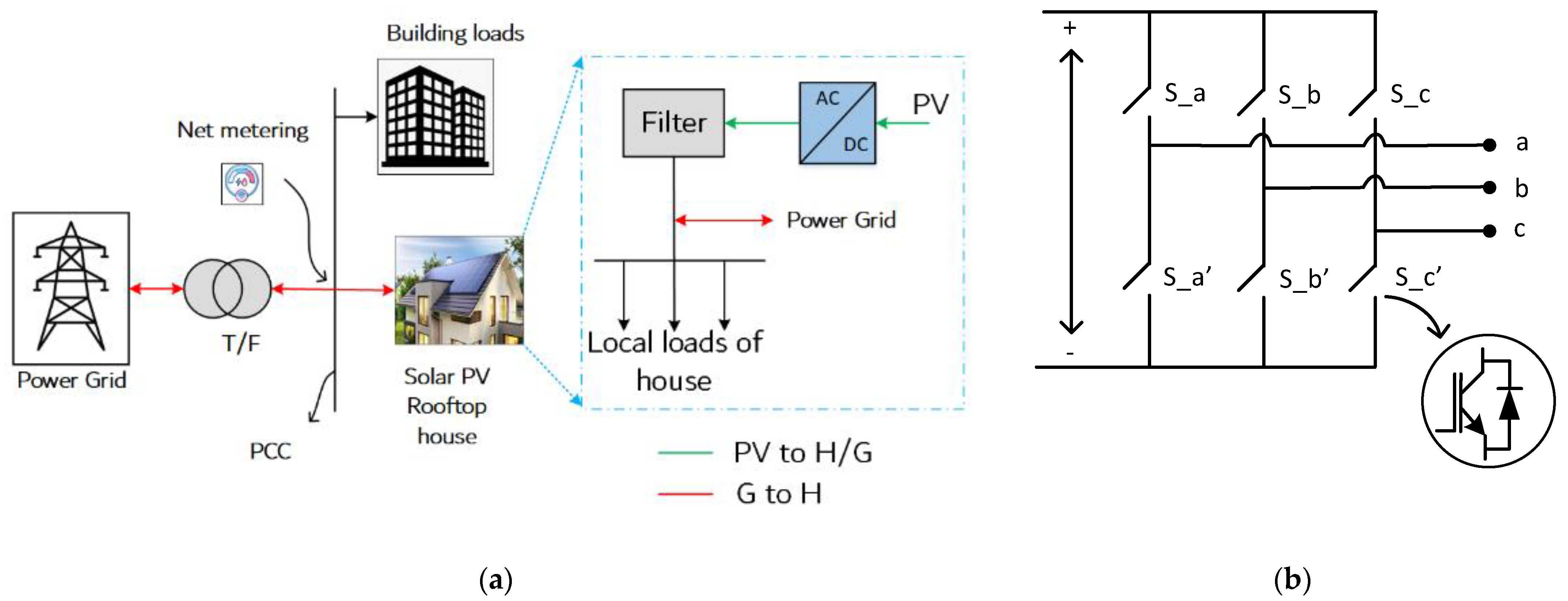


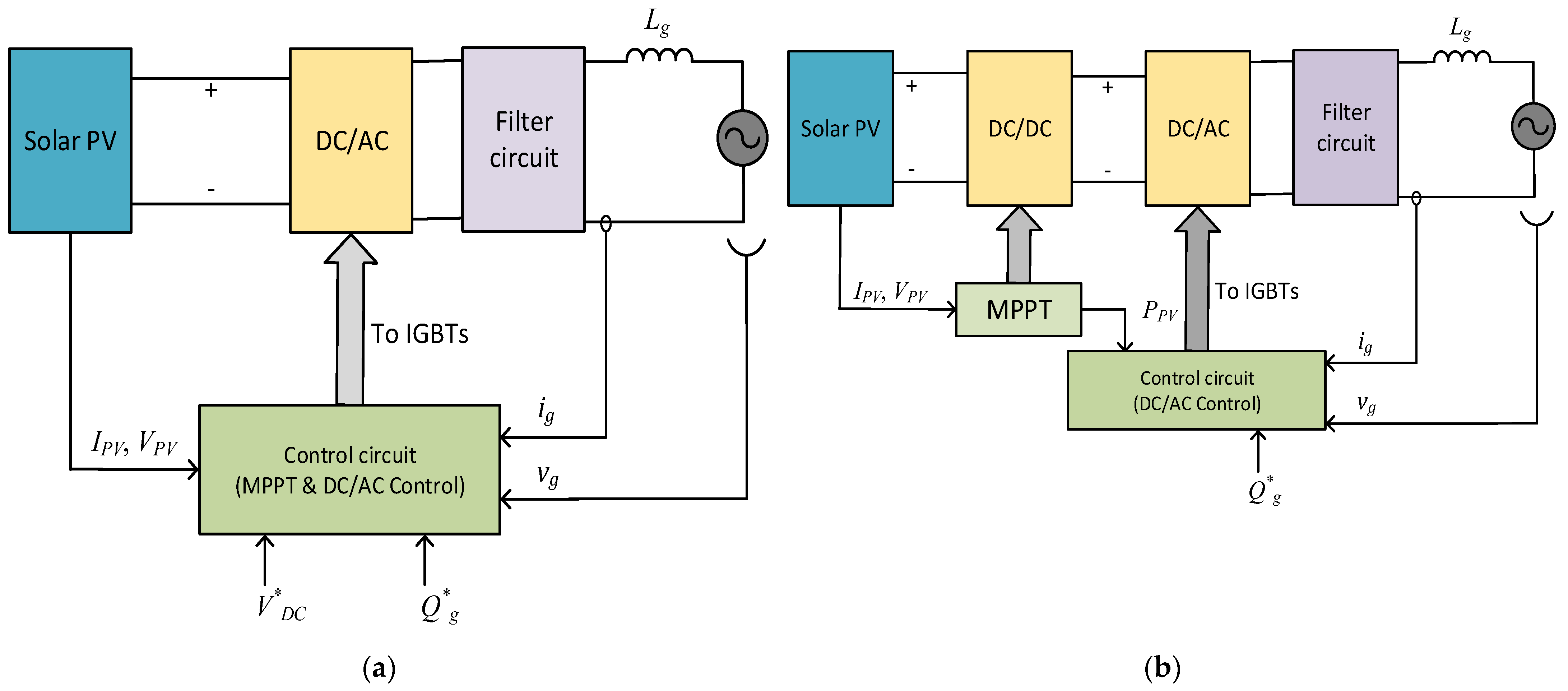
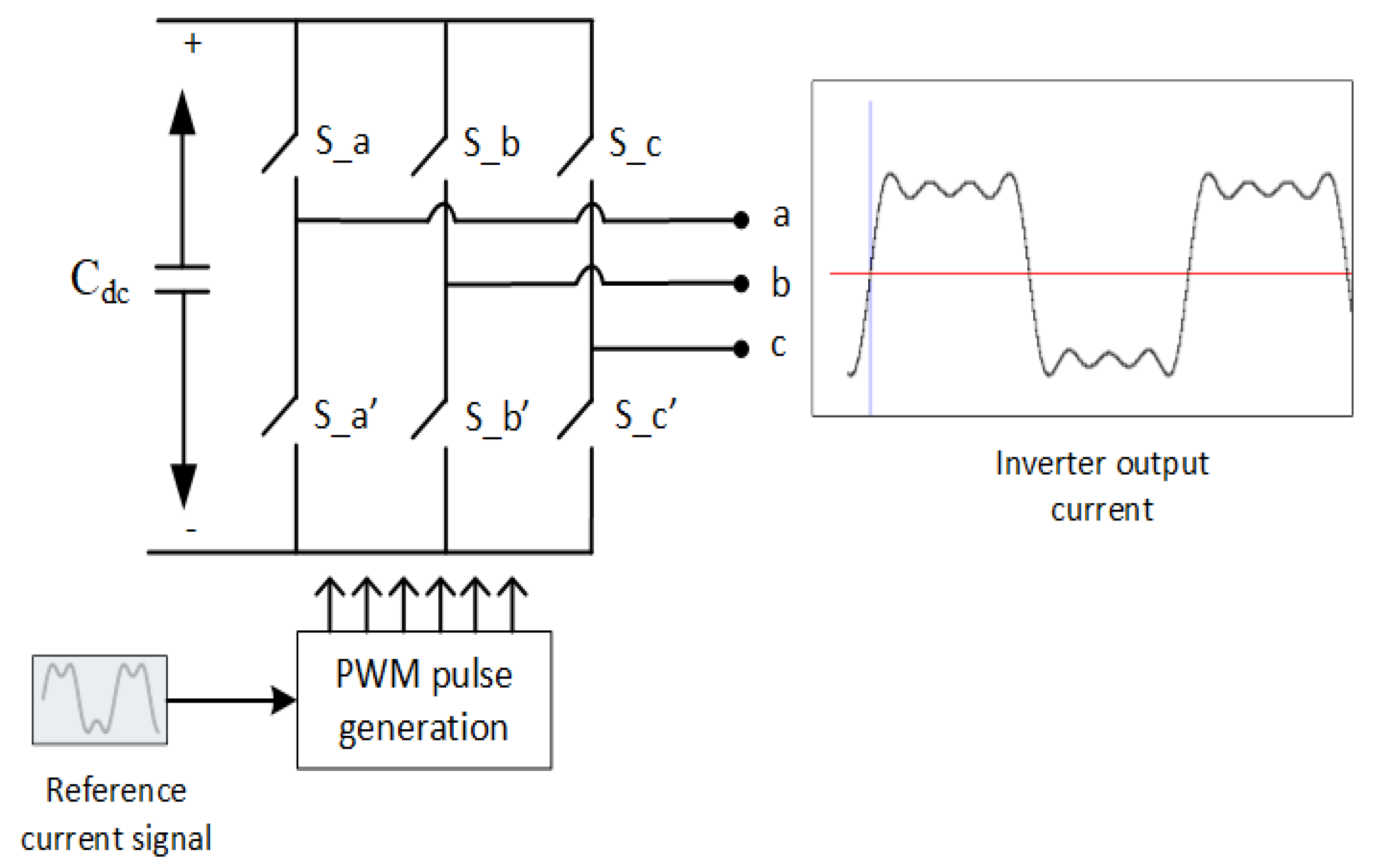
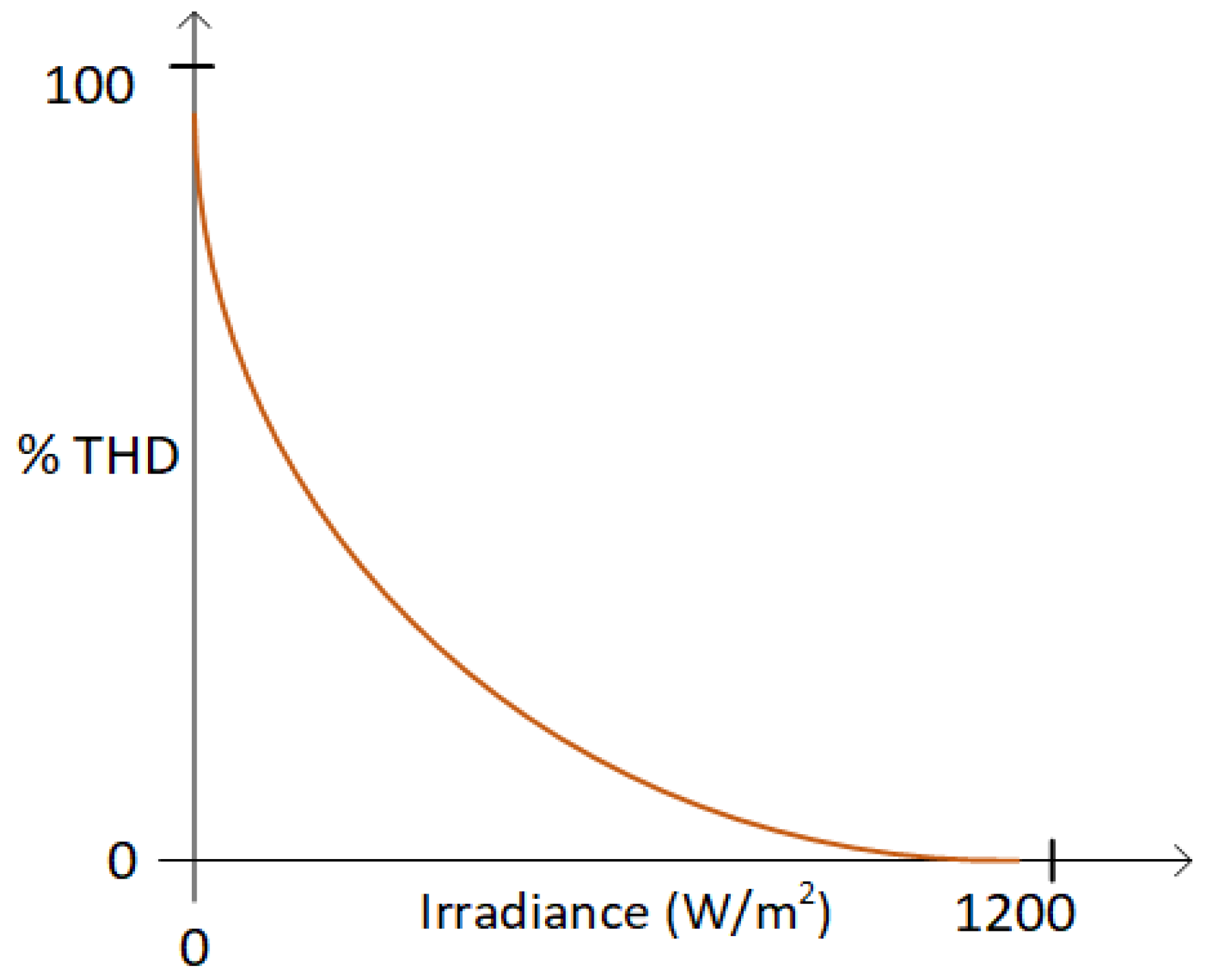


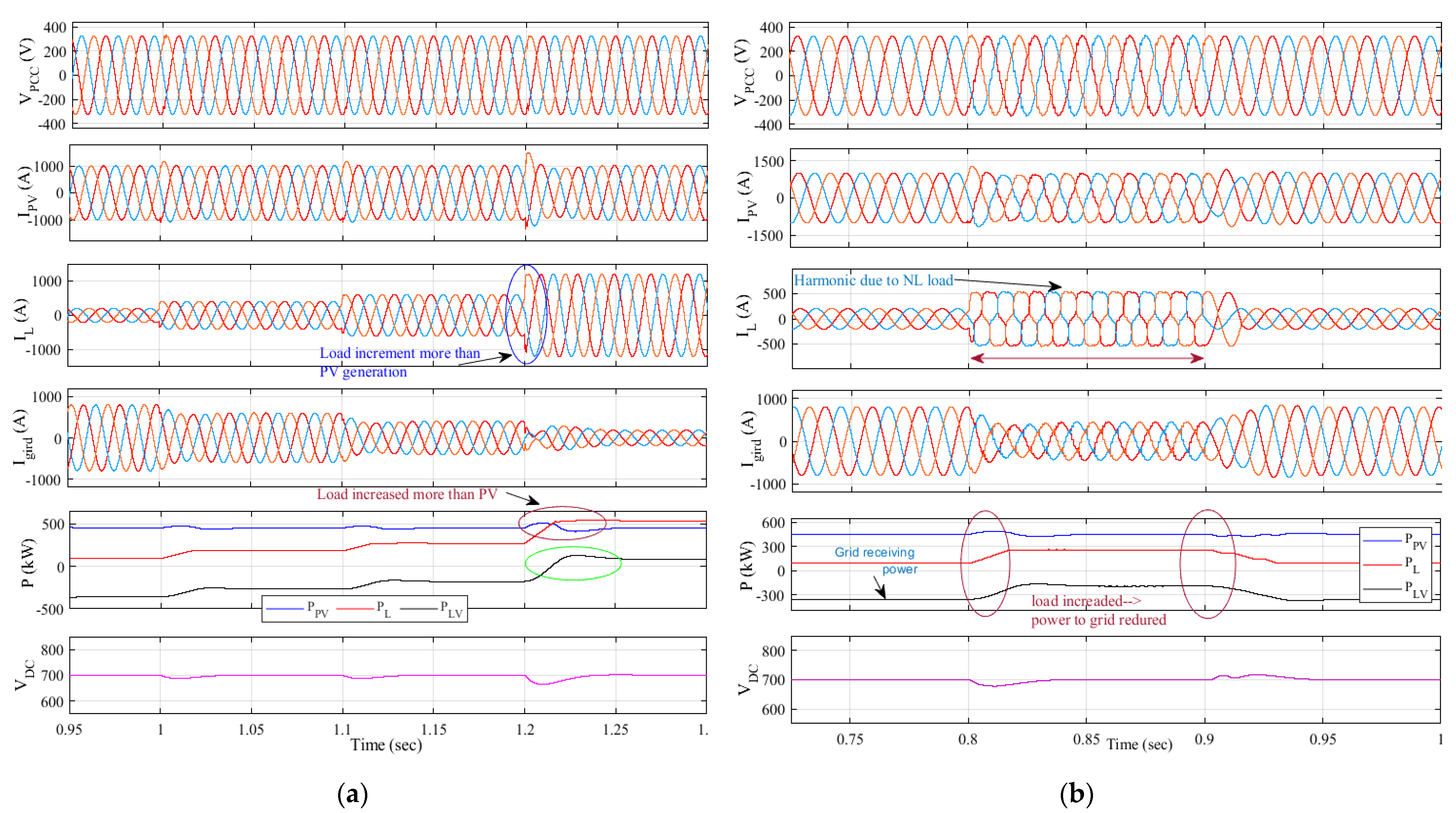

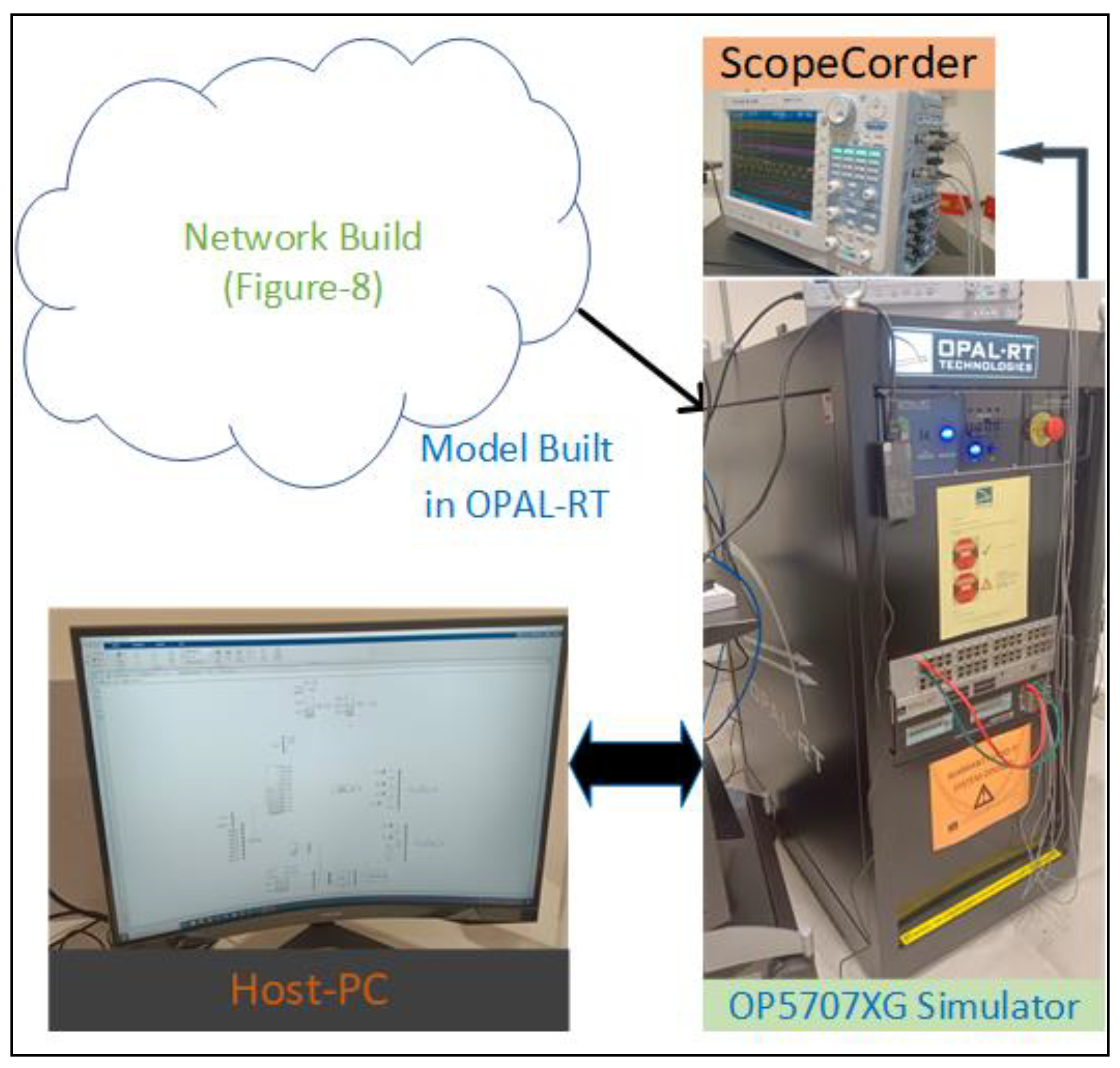
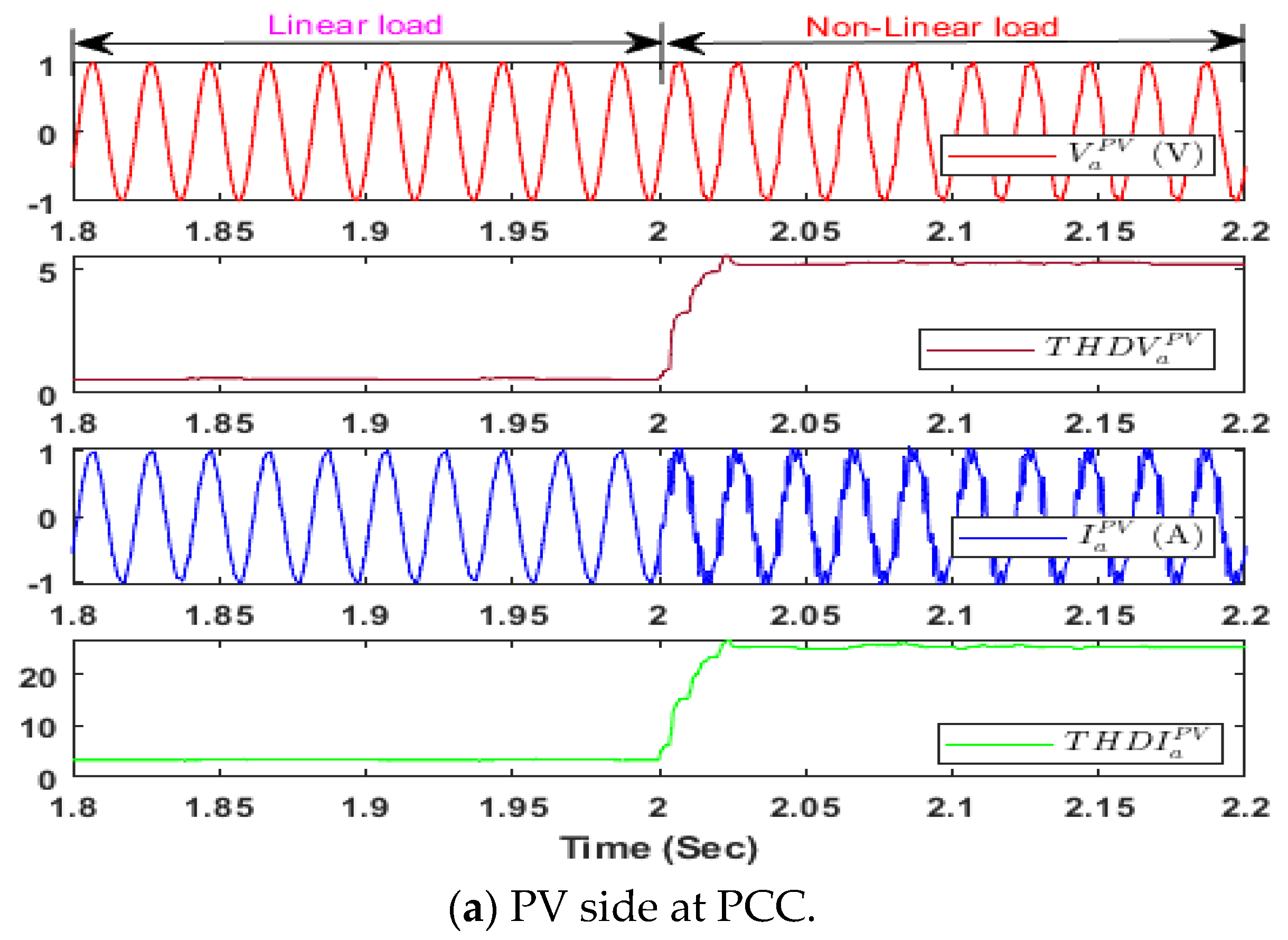

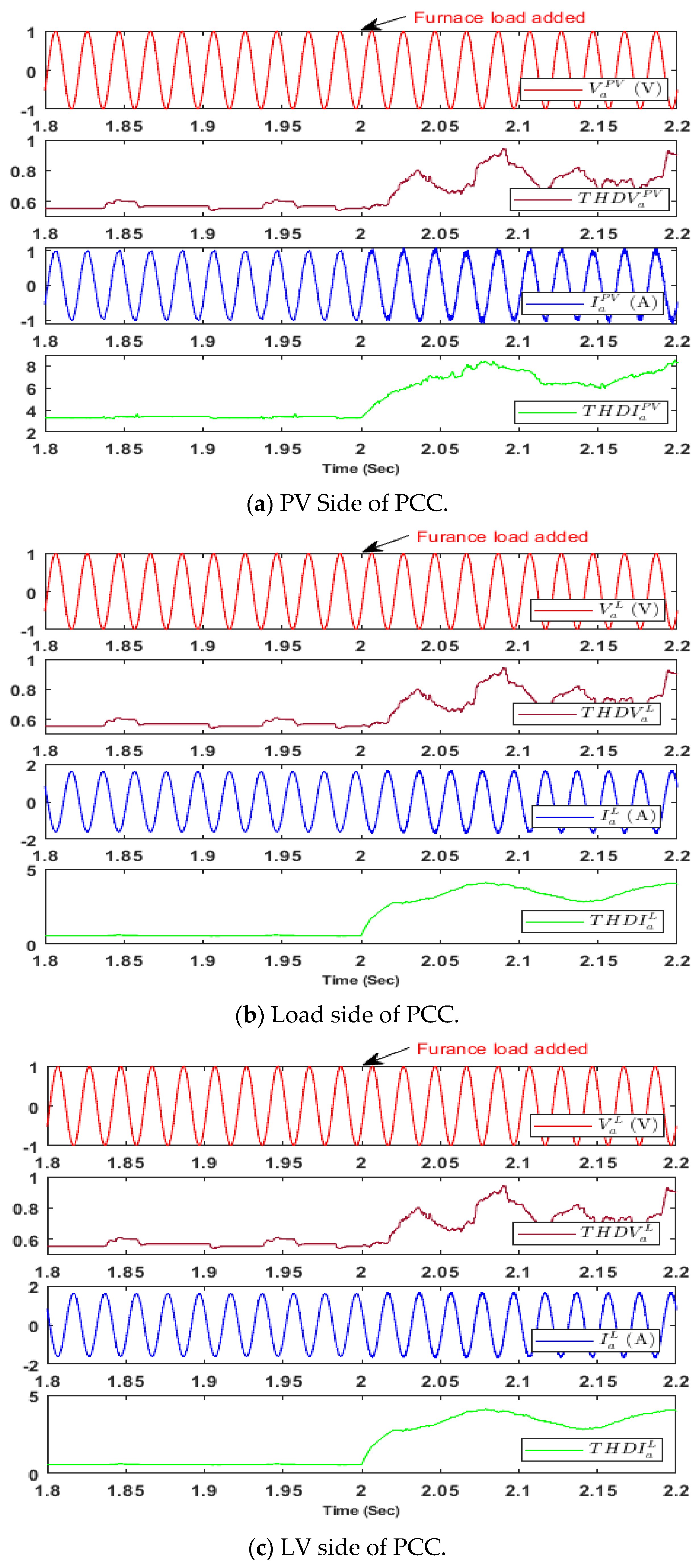
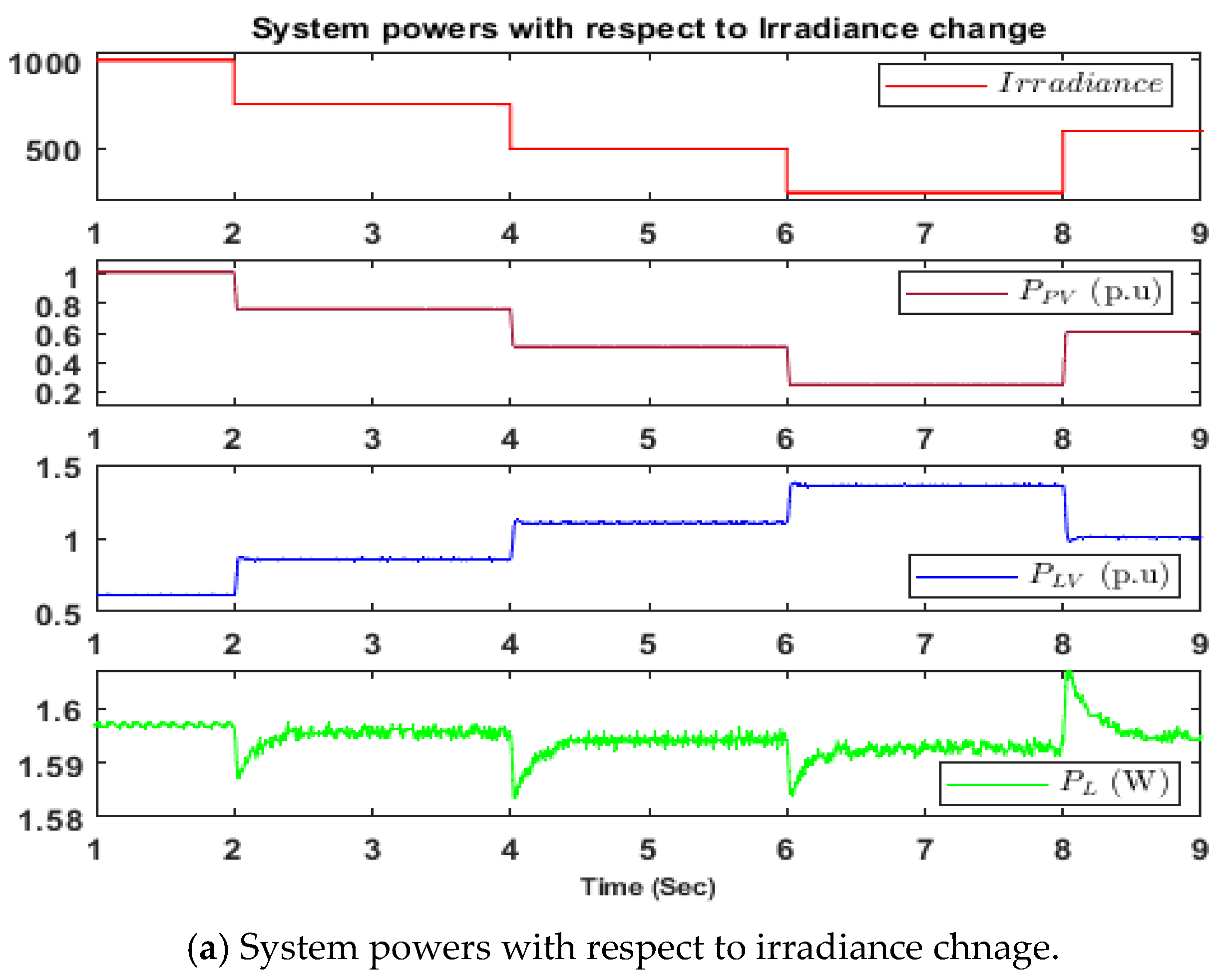

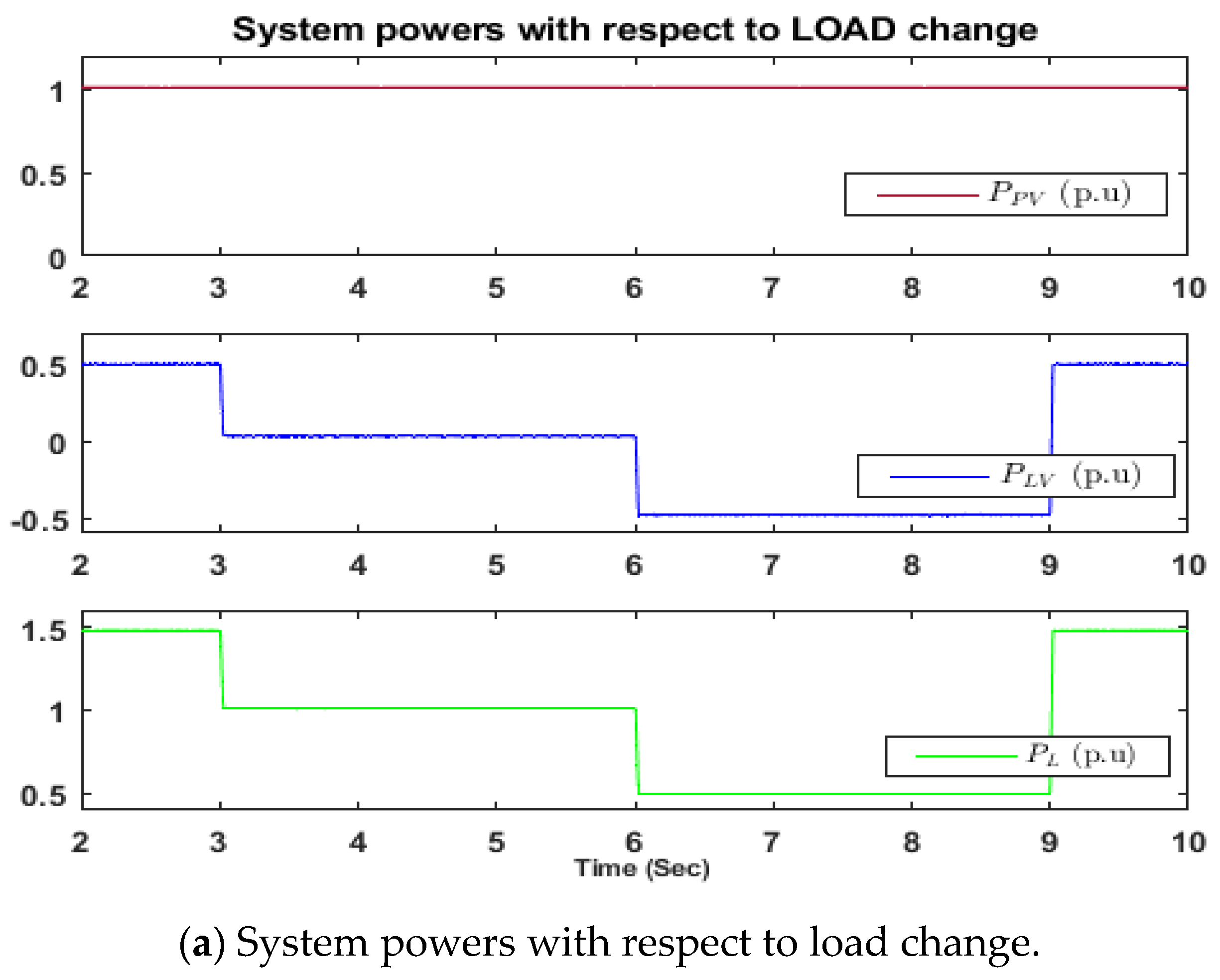


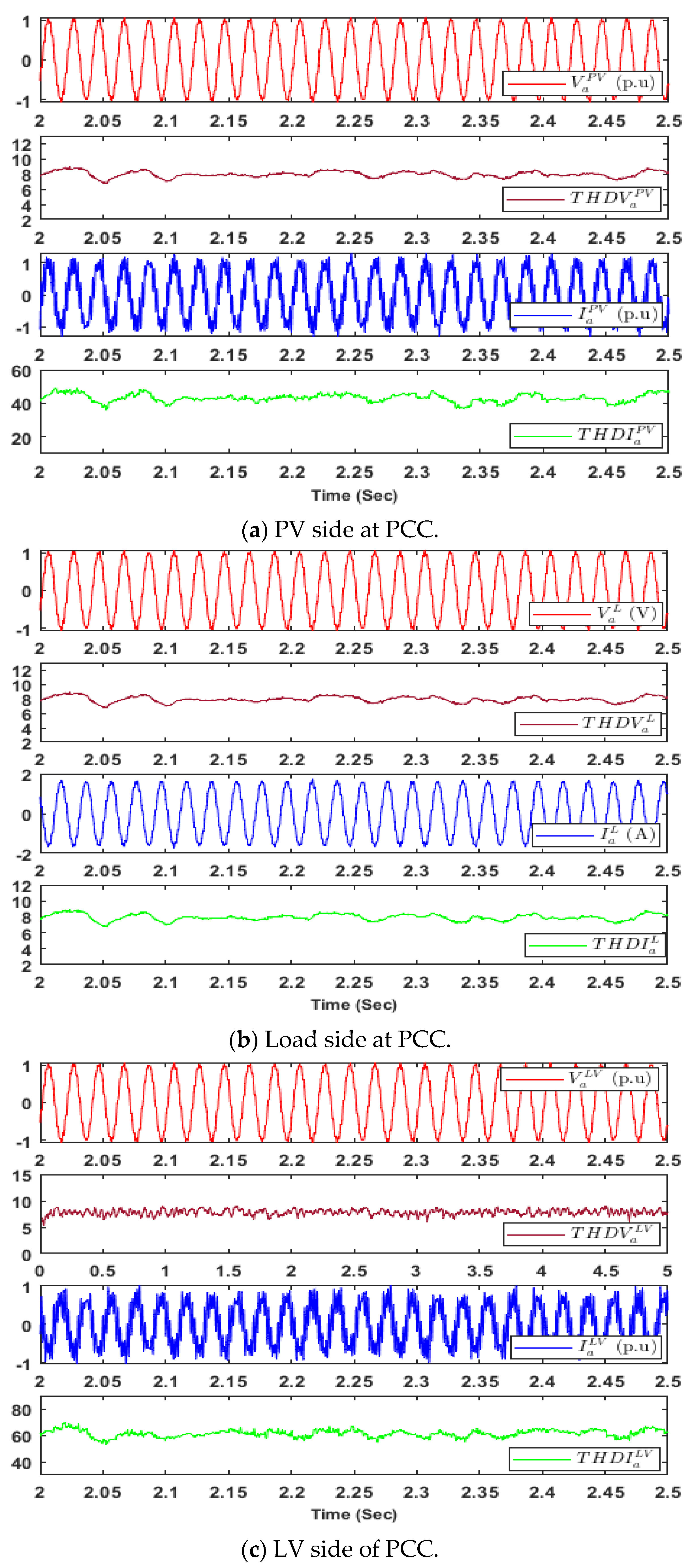
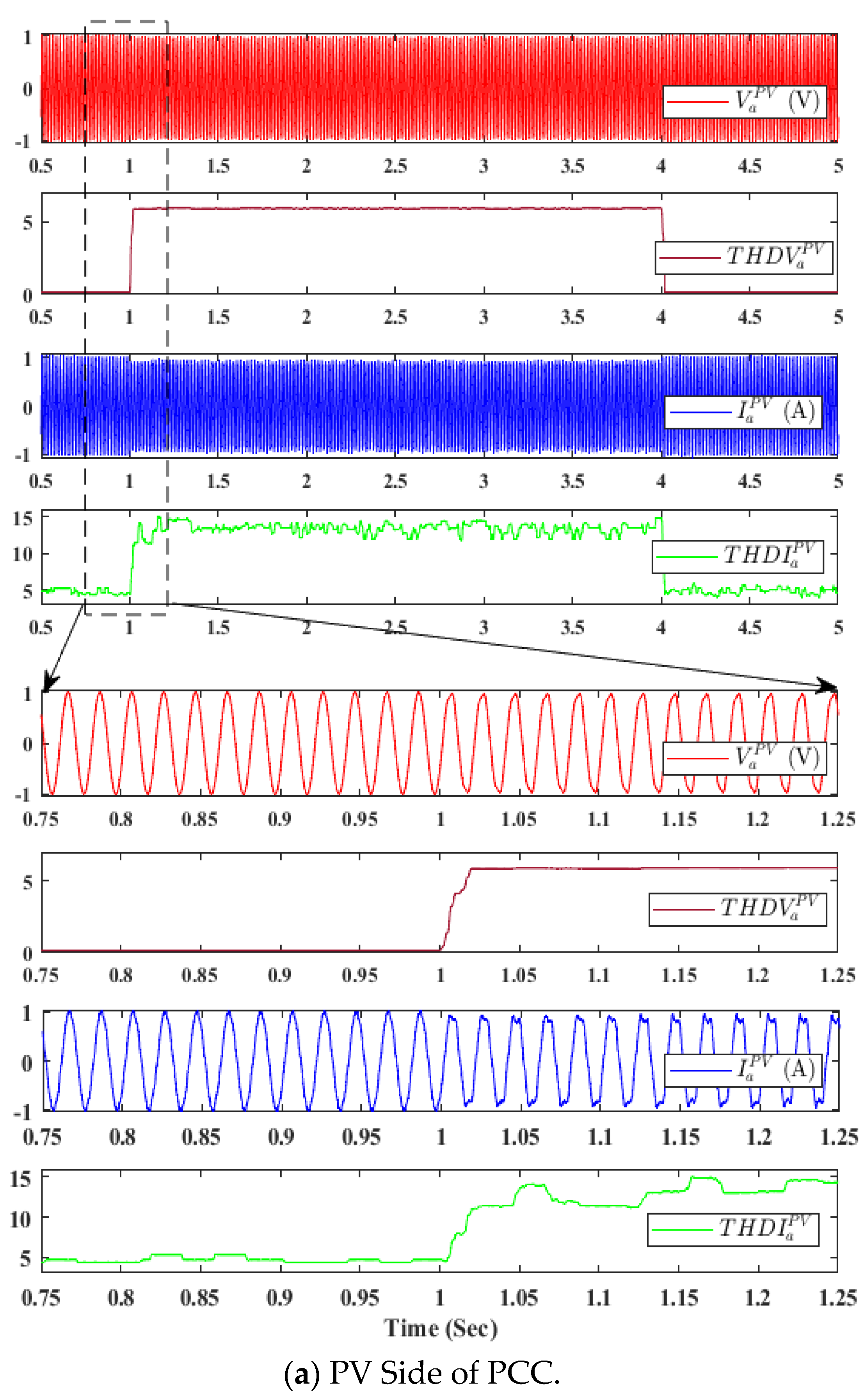
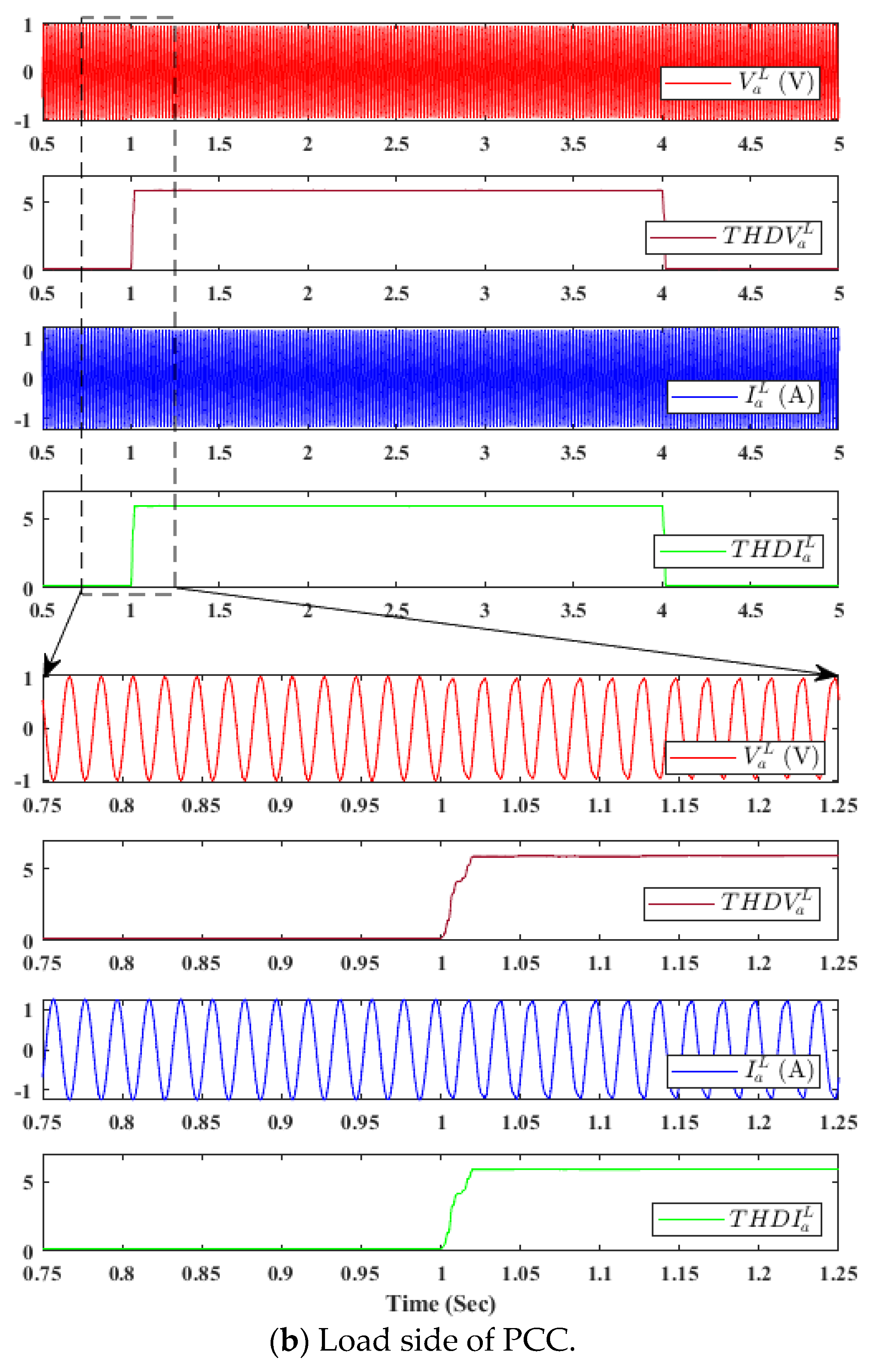
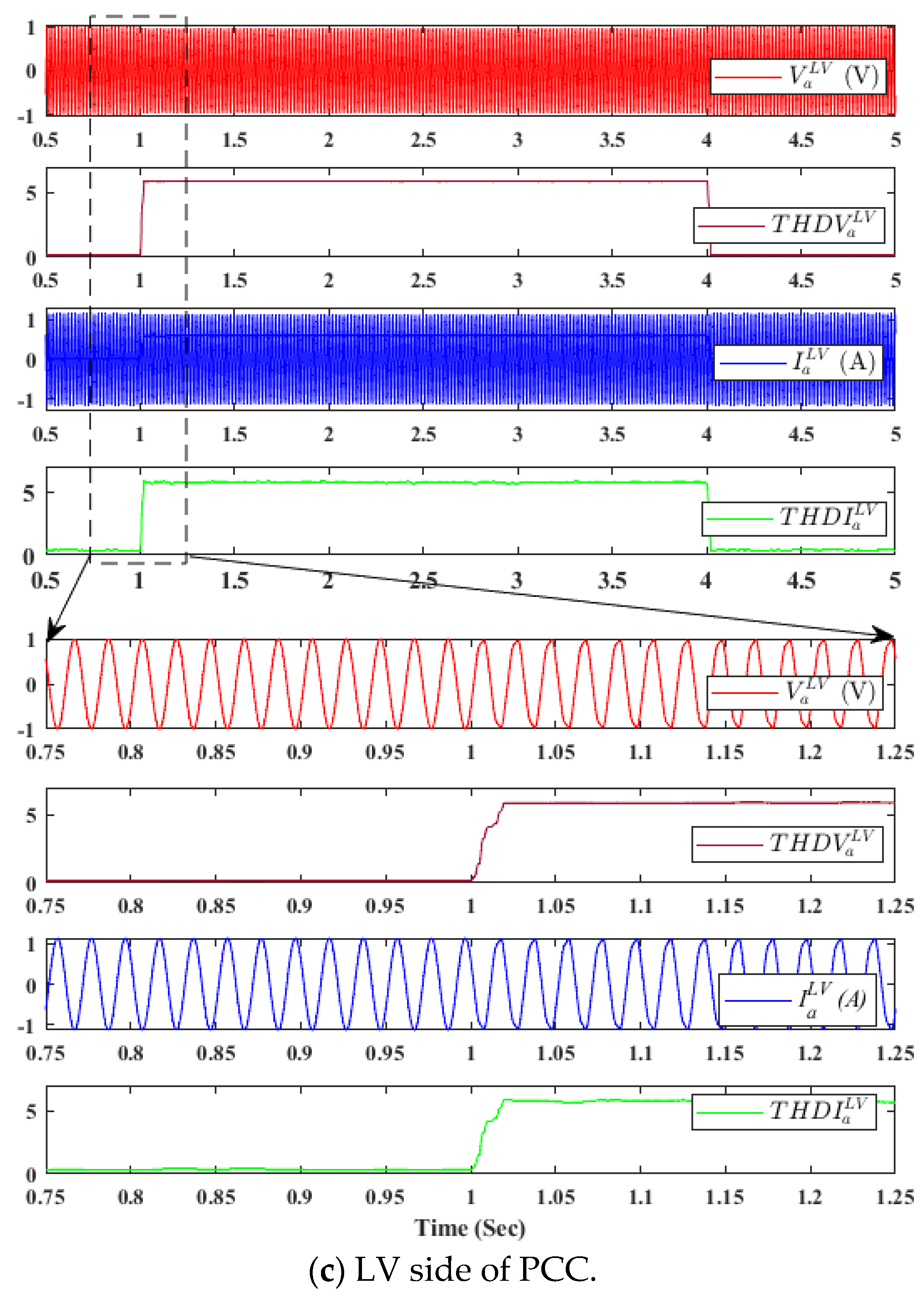
| S. No. | Types of PV Inverter | Advantages | Disadvantages |
|---|---|---|---|
| 1 | String inverters: string inverters function by connecting a series of solar panels to a single inverter, transforming the whole DC input to AC output. | Most traditional and stable/reliable; Less expensive; Because string inverters are strategically positioned on the side of a house, they are easy to monitor, repair, and replace. | Shading on one solar panel would reduce the power output of the entire string: string inverters are less efficient in optimizing solar energy production because they are connected to a complete string of solar panels. String inverters only provide total-system monitoring. This can be a drawback for diagnosing solar output concerns and bad for solar customers who desire a more detailed degree of monitoring. |
| 2 | Central inverters: central inverters are similar to the string inverters in construction. Central inverters are used in such applications where multiple strings of PV panels are combined in parallel for more power to be converted from the DC to AC grid. | Lower cost; Credibility due to presence for a long time and use in the market; Ability to produce more power; Reliable, as central inverters are placed in a protective environment. | Potential for a single point of failure: even if a single panel is shaded or fails for any reason, it will affect the entire system’s performance. There is a higher risk factor because of the high rating of the produced DC voltage, which could be life-threatening for operators, and there is a higher replacement cost. |
| 3 | Power optimizers + inverters: each solar panel has a power optimizer at its back that synchronizes with a string inverter to convert DC to AC. | Because power optimizers can condition the DC energy supplied by each solar panel, a partially shaded solar panel would not affect the output of the entire string as it would with a traditional string inverter system; In addition to system-level monitoring, power optimizers offer the advantage of providing panel-level monitoring. | These are more expensive than string inverters, as they require addition of optimizer. If one plans to increase one’s solar panel system in the future, more power optimizers and possibly more string inverters will be needed. As power optimizers are positioned on the roof, repairing and replacing them is also more difficult. |
| 4 | Microinverters: microinverters are the most recent advancement in solar inverter technology, converting DC to AC directly from the back of each solar panel. | Since each microinverter handles the DC-to-AC conversion on each panel, shading on individual panels has a negligible influence on the system; Microinverters are very simple to add to a solar system later: a microinverter is all that is needed to put on the back of any new solar panels added to the system; Like power optimizers, microinverters enable panel-level solar system monitoring, making any solar output concerns more simply and precisely diagnosed. | The costliest solar inverter option is the microinverters. However, the benefits might easily outweigh the expenses, particularly if shadowing is a concern. Because microinverters are mounted on the back of each solar panel, they are more challenging to repair or replace if they fail. |
| S. No. | Names of Control | Features of the Control Techniques in On-Grid PV Systems |
|---|---|---|
| 1 | PLL-based control [30] | Grid synchronization, grid frequency measurement, and inverter phase reference. |
| 2 | PR control [31] | Capable of reducing the steady-state error by offering extra gain at the resonant frequency. |
| 3 | LQG control [32] | Zero steady-state tracking error, channel decoupling, and noise cancellation. |
| 4 | SMC [33] | Less requirement of system parameters, insensitivity to parameter variations, and external disturbance rejection. |
| 5 | Feedback linearization control [34] | Voltage support and under fault conditions, tackles transient behavior. |
| 6 | Hysteresis control [35] | Simple and easy to implement and robust in current control performance with stability, fast response, and ability to control peak current. |
| 7 | Adaptive control [36] | Efficient handling of system uncertainties and disturbances. |
| 8 | Intelligent control [37] | It can handle voltage and frequency deviations, power fluctuations, and communication system delays. |
| 9 | Mixed: Adaptive intelligent sliding mode control [38] | Estimates the system uncertainties and has grid connection reliability, less voltage tracking error, and robustness to environmental variations |
| Name of Parameter | Scenario 1 (NL-Load1) | Scenario 2 (NL-Load1 + Nl-Load2) | ||
|---|---|---|---|---|
| Fundamental Value | % THD | Fundamental Value | % THD | |
| Load current (iL) | 572.4 (A) | 18.4 | 1114 (A) | 21.7 |
| PV current (iPV) | 1008 (A) | 8.5 | 1010 (A) | 18.36 |
| * Grid current (iLV) | 435.5 (A) | 16.87 | -108.2 (A) | 120 |
| PCC voltage (vPCC) | 325 (V) | 5.54 | 324.1 (V) | 9.48 |
| Use Cases | PV Side | Load Side | LV (Grid) Side | |||
|---|---|---|---|---|---|---|
| THDv | THDi | THDv | THDi | THDv | THDi | |
| Normal | 0.8% | 4.9% | 0.8% | 0.8% | 0.8% | 7.7% |
| Non-linear load | 5.5% | 28% | 5.5% | 9% | 5.5% | 24% |
| Furnace load | 1.0% | 5.2% | 1% | 3.5% | 1% | 8% |
| Control parameters change | 8.0% | 40% | 8% | 8% | 8% | 60% |
Disclaimer/Publisher’s Note: The statements, opinions and data contained in all publications are solely those of the individual author(s) and contributor(s) and not of MDPI and/or the editor(s). MDPI and/or the editor(s) disclaim responsibility for any injury to people or property resulting from any ideas, methods, instructions or products referred to in the content. |
© 2023 by the authors. Licensee MDPI, Basel, Switzerland. This article is an open access article distributed under the terms and conditions of the Creative Commons Attribution (CC BY) license (https://creativecommons.org/licenses/by/4.0/).
Share and Cite
Naidu, T.A.; Ali Ahmed Albeshr, H.M.; Al-Sabounchi, A.; Sadanandan, S.K.; Ghaoud, T. A Study on Various Conditions Impacting the Harmonics at Point of Common Coupling in On-Grid Solar Photovoltaic Systems. Energies 2023, 16, 6398. https://doi.org/10.3390/en16176398
Naidu TA, Ali Ahmed Albeshr HM, Al-Sabounchi A, Sadanandan SK, Ghaoud T. A Study on Various Conditions Impacting the Harmonics at Point of Common Coupling in On-Grid Solar Photovoltaic Systems. Energies. 2023; 16(17):6398. https://doi.org/10.3390/en16176398
Chicago/Turabian StyleNaidu, Talada Appala, Hamad Mohamed Ali Ahmed Albeshr, Ammar Al-Sabounchi, Sajan K. Sadanandan, and Tareg Ghaoud. 2023. "A Study on Various Conditions Impacting the Harmonics at Point of Common Coupling in On-Grid Solar Photovoltaic Systems" Energies 16, no. 17: 6398. https://doi.org/10.3390/en16176398
APA StyleNaidu, T. A., Ali Ahmed Albeshr, H. M., Al-Sabounchi, A., Sadanandan, S. K., & Ghaoud, T. (2023). A Study on Various Conditions Impacting the Harmonics at Point of Common Coupling in On-Grid Solar Photovoltaic Systems. Energies, 16(17), 6398. https://doi.org/10.3390/en16176398






